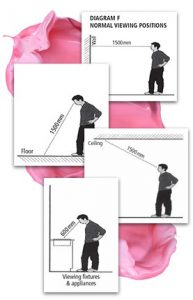Often on site visits we view a lot of painted areas. Every finish looks different depending whether you view it from front or side on, a high or low angle. How do you get a consistent way of viewing surfaces? What is really a Painting Defect here?
Standard of Painting
Coatings used are to be suitable for the relevant conditions and relevant wear and tear. Unless documented otherwise, painting is defective if it does not comply with the manufacturer’s installation instructions or AS/NZS 2311 – Guide to the painting of buildings.
Inspecting the Paintwork
Generally, variations in the surface colour, texture and finish of walls, ceilings, floors and roofs, and variations in glass and similar transparent materials are to be viewed where possible from a normal viewing position, defined as looking at a distance of 1.5 m or greater (600 mm for appliances and fixtures) with the surface or material being illuminated by ‘non-critical light’ , which is the light that strikes the surface, is diffused and is not glancing or parallel to that surface.
Surface Finish of Paintwork
Paintwork is defective if application defects or blemishes such as paint runs, paint sags, wrinkling, dust, bare or starved painted areas, colour variations, surface cracks, irregular and coarse brush marks, sanding marks, blistering, uniformity of gloss level and other irregularities in the surface that are visible from a normal viewing position. (Normal viewing position is 1.5 metres directly in front of surface)
Excessive over-painting of fittings, trims, skirtings, architraves, glazing and other finished edges is a defect.
Nail and Screw Fixings
Fixings or unfilled depressions caused by fixings are defects in painted or stained surfaces if they can be seen from a normal viewing position. (Normal viewing position is 1.5 metres directly in front of surface)
Mechanical Damage and Natural Defects in Surfaces
Holes and any other unfilled depressions in painted or stained timber such as surface defects caused by mechanical damage, natural characteristics such as gum pockets or surface splits are defects if they can be seen from a normal viewing position. (Normal viewing position is 1.5 metres directly in front of surface)
Paint Durability
Unless documented otherwise, coatings are defective if they fail by lifting, blistering, flaking, fading etc. within the minimum period shown in table below.
Minimum Durability of Coated Finishes
COATING MINIMUM DURABILITY
Exterior Acrylic 36 months
Exterior Enamel 24 months
Exterior semitransparent stains 12 months
Exterior clear finishes Not recommended
Interior – all finishes 36 months

